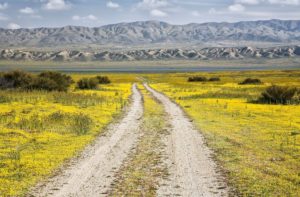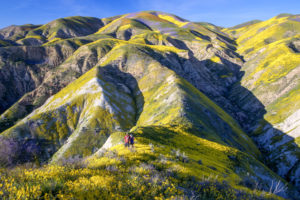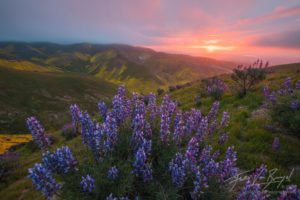Interior Secretary Ryan Zinke has officially released the “Final Report Summarizing Findings of the Review of Designations Under the Antiquities Act,” 102 days after it was promised on August 24, 2017. In addition to the massive reductions to Bears Ears and Grand Staircase-Escalante National Monuments announced by President Trump earlier this month, the report targets an additional eight monuments for vast boundary reductions and would open them up to mining, drilling, logging, and industrial-scale commercial fishing. The report also calls for all national monument management plans to be reviewed — including that of the Carrizo Plain National Monument in San Luis Obispo County.
The president’s proclamation and the Department of the Interior’s recommendations represent the largest elimination of protected federal lands and waters in U.S. history. In addition to the slashing of Bears Ears and Grand Staircase Escalante National Monuments by a combined total of 2 million acres, the report suggests shrinking Nevada’s Gold Butte, and the Cascade-Siskiyou that lies on the Oregon and California border. It recommends gutting protections for Organ Mountains-Desert Peaks (New Mexico), Katahdin Woods and Waters (Maine), Rio Grande del Norte (New Mexico), Northeast Canyons and Seamounts (Atlantic Ocean), Pacific Remote Islands (Pacific Ocean), and Rose Atoll Marine (Pacific Ocean) to allow logging, industrial scale fishing, mining, and oil drilling as well as a reassessment of the Resource Management Plans of the other national monuments encompassed in the review for provisions the Department of the Interior deems too restrictive.
“Together, these changes mean millions of acres of public land will be opened up to drilling, mining, and other activities that will degrade the monuments and preclude almost any other use,” said Rebecca August, Public Lands Advocate at Los Padres ForestWatch. “The Secretary and the President claim that their changes are to allow hunting, fishing, vehicle access, and grazing, but national monuments managed by the BLM already allow these activities, and monument designation honors existing rights and easements.”
For now, the boundaries of the Carrizo Plain — one of the 27 national monuments targeted in the review — have been preserved. What remains uncertain is the future of its Resource Management Plan, which governs activities such as oil drilling and cattle grazing. The plan was completed in 2010 after a multi-year process involving public meetings, formal comment periods, and input from various stakeholders. It allows off-road vehicle access, hunting, some generational grazing to control invasive weeds, and the operation of legacy oil wells. In place for the last 7 years, Carrizo Plain’s Resource Management Plan enjoys universal support among various stakeholders including oil companies, livestock operators, Native American tribes, land management agencies, conservation organizations, and the public — all of which are represented on the Carrizo Plain National Monument Advisory Committee which has helped manage the monument since its designation by President Clinton in 2001.
“The president and the secretary’s actions make all our public lands vulnerable to political whim,” said August. “National Monuments like the Carrizo Plain are often comprised, in whole or in part, of land that has been painstakingly purchased or donated by private individuals and non-profit organizations for the purpose of conservation. If this administration assumes the power to give this land over to industrial development at will, then any administration can do so.”
According to the Antiquities Act, Presidents may designate national monuments, but only Congress may modify or change their management. Interior Secretary Zinke insists in the “lawful exercise of the President’s discretion” to shrink the size of national monuments, but legal scholars have pointed out that the President holds no such discretion. The unilateral changes proposed in the report are in violation of the act itself, and unchallenged, would set a precedent that makes the conservation of public lands impossible.
“This is an extreme abuse of the Antiquities Act by a sitting president,” said Bryant Baker, ForestWatch’s Conservation Director. “We will continue to advocate for the full protection of all existing national monuments and the continued use of the Antiquities Act to protect other national treasures.”

One of the roads visitors can use to access different areas of the Carrizo Plain National Monument, with the Temblor Range in the distance. Photo by Bill Bouton
The premise of this review — ordered by President Trump in April 2017 – was that outreach to the public prior to monument designation had been insufficient. During the 120 day public comment period this summer, the Department of the Interior received record-breaking 1.4 million comments. Non-profit land advocacy groups like Los Padres ForestWatch, recreation clubs, and outdoor retailers like Ventura-based Patagonia helped engage the public in the review process. Zinke rebuked this activity and suggested that the voices of those who took the time to send emails through action alerts or to fill out pre-addressed postcards didn’t count.
The secretary conceded that the comments “were overwhelmingly in favor of maintaining existing monuments,” and an independent analysis confirms that 98% were in support of keeping national monument protections in place. Yet, both the president and the secretary claim that their actions are based on public input. In his report, the secretary discounts most public comments in defense of monuments as “form comments associated with NGO-organized campaigns,” and dismisses the large number of attendees of public hearings held around the country during the review as “advocates organized by non-governmental organizations (NGO) to promote monument designations.”
The Carrizo itself garnered widespread public support, including 166 businesses throughout the Central Coast region, 32 local elected officials, 4 chambers of commerce, 45 community organizations, and nine newspapers along with thousands of residents who submitted letters and postcards urging that the Carrizo Plain remain protected.









Comments are closed.